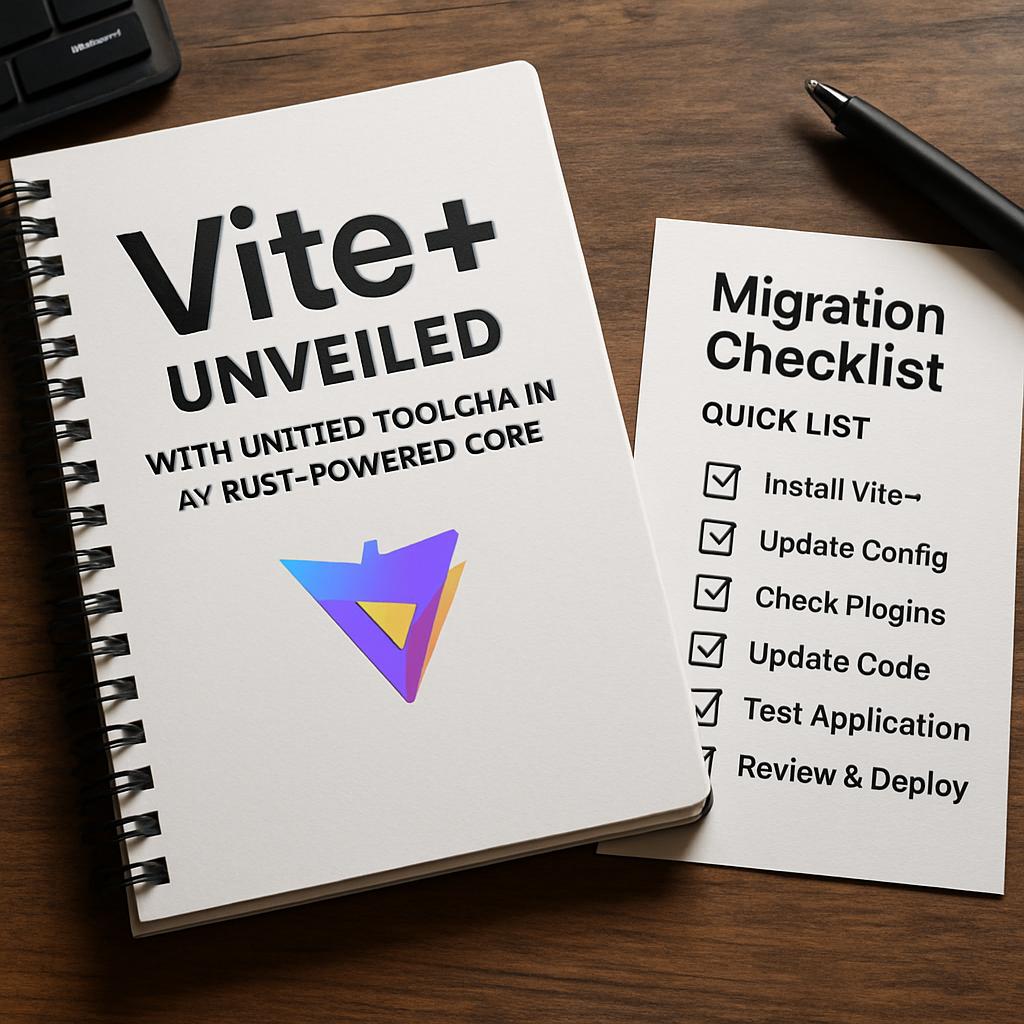The web development toolchain is changing faster than ever, and the arrival of a Vite variant built around a unified toolchain and a Rust-powered core promises to accelerate that shift. This article walks through what this approach means for developers, how it changes day-to-day workflows, and why a Rust engine under the hood matters for both local dev and production builds.
- Why a unified toolchain matters now
- What the unified toolchain actually provides
- Developer workflow improvements
- Why a Rust-powered core changes the game
- How Rust affects transformation and bundling
- Performance and practical comparisons
- Compatibility and the plugin ecosystem
- Real-world migration: my experience with a mid-sized app
- Best practices and troubleshooting
- Migration checklist (quick list)
- Broader implications for the web ecosystem
- Where things go from here
Why a unified toolchain matters now

Modern front-end projects juggle compilers, bundlers, dev servers, type checkers, and a pile of plugin adapters. Each piece solves a problem, but the cost is complexity: subtle mismatches, version friction, and confusing configuration. A unified toolchain aims to reduce that surface area by offering a single, coherent runtime for building, serving, and bundling web apps.
That coherence doesn’t just simplify config files. It encourages predictable behavior across environments, lowers onboarding time for new engineers, and makes reproducible builds easier. For teams shipping features frequently, fewer tooling surprises translate directly into fewer interrupted sprints.
What the unified toolchain actually provides
A true unified toolchain combines the dev server, HMR (hot module replacement), code transformation, and production bundling into one integrated system. Instead of orchestrating separate processes that communicate via adapters, everything runs inside the same pipeline with consistent plugin hooks and shared caching strategies.
This setup reduces context switching for plugin authors and improves cache reuse between development and production, so transformations you apply during local development are less likely to diverge from the final bundle output. That consistency is especially valuable when using advanced patterns like SSR, edge functions, or fine-grained code splitting.
Importantly, a unified toolchain doesn’t have to be monolithic. The architecture can still be modular and extensible while presenting a single configuration surface to the developer, making it easier to adopt or replace parts of the pipeline without breaking the whole build.
Developer workflow improvements
Once the server, transformer, and bundler speak the same language, workflows become more fluid. Expect faster HMR that preserves state more reliably and fewer rebuild quirks when toggling between development and production modes. The result is less time debugging tooling and more time iterating on features.
For teams, the simplification also reduces cognitive load. A developer who switches between repositories sees a familiar command set and predictable behavior, which lowers the mental overhead when context switching between projects or codebases.
Why a Rust-powered core changes the game
Rust has become a favorite for systems that require performance without sacrificing safety. Compilers and code transformation engines benefit from Rust’s low-level control over memory and concurrency while retaining strong compile-time checks that prevent entire classes of bugs. Embedding a Rust core into a web toolchain brings both throughput and reliability.
Rust-based engines typically start faster, handle concurrency more efficiently, and offer smaller memory footprints than their JavaScript counterparts. Those characteristics translate into snappier dev servers, quicker cold starts in CI, and more efficient use of developer machines—especially on resource-constrained systems or monorepos with many packages.
Beyond raw speed, Rust opens opportunities for tighter native integration with platform features, such as efficient filesystem watchers and cross-platform binary distributions, which make installing the tooling and running it on build servers more predictable.
How Rust affects transformation and bundling
Transformers written in Rust can parse, analyze, and rewrite JavaScript, TypeScript, and CSS far faster than equivalent implementations running on the JavaScript runtime alone. With a Rust core, the pipeline can push heavy lifting into native threads and avoid round-trips through the JS event loop for CPU-bound work.
The practical effect is shorter build times and reduced latency during incremental updates. For large codebases, Rust-driven operations often offer a more linear scaling curve, keeping developer feedback loops tight even as the project grows.
Performance and practical comparisons
Benchmarks vary by project, hardware, and workload, so I won’t claim a universal number. What tends to be consistent is that Rust-powered tooling excels at cold starts and CPU-heavy transforms. Incremental updates and dev-server responsiveness also see noticeable improvements on average.
Performance gains are particularly visible in large monorepos or applications with many small files, where transformation overhead dominates. The combination of a unified cache across dev and build steps and a native execution engine reduces duplicate work and speeds up both local development and CI pipelines.
| Characteristic | Traditional JS toolchains | Unified toolchain with Rust core |
|---|---|---|
| Cold start | Often slower, more I/O | Faster, optimized native IO |
| HMR responsiveness | Good, but can degrade | More consistent and snappier |
| Build consistency | Potential for divergence | Higher fidelity between dev and prod |
Compatibility and the plugin ecosystem
One of the design challenges is keeping plugin ecosystems healthy. Tooling that rewrites how plugins hook into the pipeline risks breaking existing plugins or forcing authors to port their work. A successful unified system offers compatibility layers and simple migration paths so the community’s investments remain usable.
Maintainers typically provide adapter layers so older plugins can run unmodified, while encouraging new plugin APIs that leverage the native core for performance. That dual strategy eases transition without stifling progress.
For front-end frameworks—React, Vue, Svelte, and others—maintaining fast, stable integrations is a top priority. Expect framework teams and popular libraries to release compatibility docs and guides early in a migration cycle to reduce friction for their users.
Real-world migration: my experience with a mid-sized app
In a recent project, I migrated a mid-sized React app from a multi-tool setup to a single unified toolchain centered on a Rust engine. The migration was tactical: we started with a small feature branch, replaced the dev server, and verified HMR and JSX transforms before switching the CI pipelines.
The transition was surprisingly smooth because the unified toolchain retained common plugin hooks and provided a compatibility adapter for our existing custom transforms. Most of the work involved updating a few configuration entries and testing edge cases around SSR and environment-specific imports.
After migration, developer feedback was immediate: local startups felt snappier, HMR was more reliable, and fewer “works on my machine” incidents made it to code review. These qualitative improvements translated into faster iteration cycles and higher morale on the team.
Best practices and troubleshooting
When adopting a new toolchain, take an incremental approach. Start with the dev server in a single feature branch, validate behavior with your test suite, and stage production builds in a parallel CI job before switching default pipelines. This minimizes risk and gives you rollback points if something unexpected appears.
Watch for gotchas around native add-ons or binary dependencies. Because the core is Rust-based, native extensions might require prebuilt binaries for your CI and developer environments. Using official distribution tools and pinned versions eliminates many headaches.
Finally, keep an eye on cache invalidation. Unified caches are powerful, but if your build metadata or plugin hooks change, stale caches can cause confusing behavior. Add clear cache-bust steps to your release checklist so builds remain predictable.
Migration checklist (quick list)

- Start with a small repo or feature branch to test the unified dev server.
- Verify HMR, SSR, and important plugin integrations early.
- Run production builds in parallel on CI before switching defaults.
- Pin binary dependencies and provide CI-friendly prebuilds if needed.
- Document cache-cleaning steps for the team and release automation.
Broader implications for the web ecosystem
Toolchains that combine predictability, performance, and developer ergonomics change the kinds of abstractions developers can build. Faster feedback loops encourage smaller, safer commits and enable new innovations in on-device builds or edge-first deployment patterns. In short, improvements at this level ripple outward.
With a Rust-powered core and unified workflow, teams can expect fewer tooling surprises and more consistent outputs. That stability frees engineering time for product work and experimentation rather than chasing down build issues and dependency mismatches.
Where things go from here
The evolution toward unified, native-accelerated tooling is likely to continue. Expect tighter integrations with cloud and edge platforms, better diagnostics, and richer plugin contracts that expose native performance without sacrificing extensibility. Community tooling will likely coalesce around the patterns that prove most reliable and ergonomic.
For developers, the choice to adopt early depends on risk tolerance and team priorities. Projects that prioritize fast iterations and developer experience stand to gain sooner, while conservative teams may choose a staged adoption once community plugins and migration docs mature.
If you want to explore these developments further and read practical guides, check out the resources and analysis available on our site. For more articles like this and to stay current with tooling trends, visit https://news-ads.com/ and read other materials from our website.







